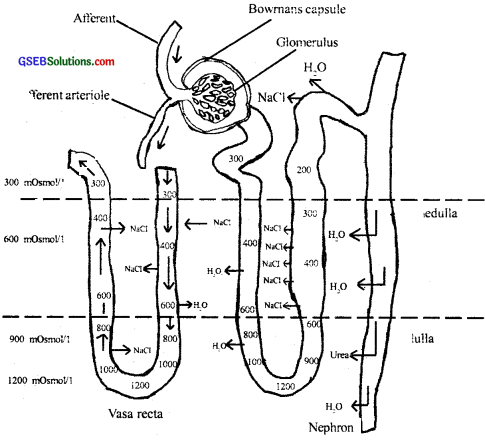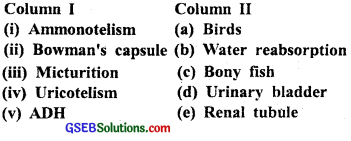Gujarat Board GSEB Textbook Solutions Class 11 Biology Chapter 19 Excretory Products and their Elimination Textbook Questions and Answers.
Gujarat Board Textbook Solutions Class 11 Biology Chapter 19 Excretory Products and their Elimination
GSEB Class 11 Biology Excretory Products and their Elimination Text Book Questions and Answers
Question 1.
Define glomerular filtration rate (GFR).
Answer:
The amount of filtrate formed by the kidneys per minute is called glomerular filtration rate (GFR). GFR in a healthy individual is approximately 125 ml/minute, i.e., 180 liters per day.
Question 2.
Explain the autoregulatory mechanism of GFR.
Answer:
The kidneys have built-in mechanisms for the regulation of glomerular filtration rate. One such efficient mechanism is carried out by the juxtaglomerular apparatus (JGA). JGA is a special sensitive region formed by cellular modifications in the distal convoluted tubule and the afferent arteriole at the location of their contact. A fall in GFR can activate the JG cells to release renin which can stimulate the glomerular blood flow and thereby the GFR back to normal.
![]()
Question 3.
Indicate whether the following statements are true or false:
- Micturition is carried out by a reflex.
- ADH helps in water elimination, making the urine hypotonic.
- The protein-free fluid is filtered from blood plasma into the Bowman’s capsule.
- Henle’s loop plays an important role in concentrating the urine.
- Glucose is actively reabsorbed in the proximal convoluted tubule.
Answer:
- (T) True
- (F) False
- (F) False
- (F) False
- (T) True
Question 4.
Give a brief account of the countercurrent mechanism.
Answer:
The Henle loop and vasa recta play a significant role in producing concentrated urine. The flow of filtrate in the two limbs of Henle’s loop is in opposite direction and thus forms a counter current. The flow of blood through two limbs of vasa recta is also in a counter-current pattern.
The proximity between the Henle’s loop and vasa recta, as well as the counter-current in them, help in maintaining an increasing osmolarity towards the inner medullary interstitium, i.e. from 300 m Osmol L-1 in the cortex to about 1200 m Osmol L-1 in the inner medulla.
This gradient is mainly caused by NaCI and urea. NaCI is transported by the ascending limb of Henle’s loop which is exchanged with the descending limb of the vasa recta. NaCI is returned to the interstitium by the ascending portion of vasa recta. Similarly, small amount of urea enter the thin segment of the ascending limb of Henle’s loop which is transported back to the interstitium by the collecting tubule.
The transport mechanism described above is called the countercurrent mechanism which helps to maintain a concentration gradient in the medullary interstitium which helps in easy passage of water from the collecting tubule thereby concentrating the filtrate.

![]()
Question 5.
Describe the role of the liver, lungs, and skin in excretion.
Answer:
Our lungs remove large amounts of CO2 (18 liters/day) and also significant quantities of water every day. The liver, the largest gland in our body secretes bile containing substances like bilirubin, biliverdin, cholesterol, degraded steroid hormones, vitamins, and drugs. Most of these substances are ultimately passed out along with digestive wastes.
The sweat and sebaceous glands in the skin can eliminate certain substances through their secretions. The sweat produced by the sweat glands is a watery fluid containing NaCl, a small amount of urea, lactic acid, etc. Though the primary function of sweat is to facilitate a cooling effect on the body surface, it also helps us in the removal of some of the wastes mentioned above. Sebaceous glands eliminate certain substances like sterols, hydrocarbons, and waxes through sebum. This secretion provides a protective oily covering for the skin.
![]()
Question 6.
Explain micturition.
Answer:
Vim formed by the nephrons is ultimately carried to the urinary bladder where it is stored till a voluntary signal is given by the central nervous system (CNS). This signal is initiated by the stretching of the urinary bladder as it gets filled with urine. In response, the stretch receptors on the walls of the bladder send signals to ie CNS. The CNS passes on motor messages to initiate the contraction of smooth muscles of the bladder and simultaneous relaxation of the urethral sphincter causing the release of urine. The process of release of urine is called micturition and the neural mechanisms causing it is called the micturition reflex.
Question 7.
Match the items of Column I with those of column II

Answer:
- Bony fish
- Renal tubule
- Urinary bladder
- Birds
- Water reabsorption
![]()
Question 8.
What is meant by the term osmoregulation?
Answer:
Metabolic activities of the body are accompanied by the liberation of energy and the formation of a variety of by-products. Most of these by-products are useful and few are harmful which need to be eliminated from the body of an animal. A large volume of CO2 and water are produced by the metabolism of carbohydrates, fats, and proteins during cellular respiration. CO2 is highly volatile and removed as gas from the respiratory surface during respiration.
It is also an important component in the synthetic and regulatory machinery of animals and plants.CO2 is an important component to maintain acid-base balance in the body. Water is also volatile and a part of it is only removed from the lungs as vapors along with the expired air. Removal of the excess water from the body to keep the water contents constant in the body is called osmoregulation.
Question 9.
Terrestrial animals are generally either ureotelic or uricotelic, not ammonotelic, why?
Answer:
Many aquatic creatures are ammonotelic which excrete ammonia as a waste product. Ammonia is generally excreted by diffusion across body surfaces as ammonium ions. Kidneys do not play any significant role in its removal. Terrestrial adaptation necessitated the production of lesser toxic acid for the conservation of water. Hence terrestrial animals are mostly ureotelic (excrete urea) and uricotelic (excrete uric acid).
![]()
Question 10.
What is the significance of the juxtaglomerular apparatus (JGA) in kidney function?
Answer:
The kidneys have built-in mechanisms for the regulation of glomerular filtration rate. One such efficient mechanism is carried out by the juxtaglomerular apparatus (JGA). JGA is a special sensitive region formed by cellular modifications in the distal convoluted tubule and the afferent arteriole at the location of their contact. A fall in GFR can activate the JG cells to release renin which can stimulate the glomerular blood flow and thereby the GFR back to normal.
JGA, a specialized portion of the nephrons plays a significant role in the regulation of GFR. A fall in glomerular blood flow/glomerular blood pressure/GFR can activate the JG cells to release renin which converts angiotensinogen in the blood to angiotensin I and further to angiotensin II. Angiotensin II, being a powerful vasoconstrictor, increases the glomerular blood pressure and thereby GFR. Angiotensin II also activates the adrenal cortex to release Aldosterone. Aldosterone causes reabsorption of Na+ and water from the distal parts of the table. This also leads to an increase in blood pressure and GFR. This complex mechanism is generally known as the Renin-Angiotension mechanism.
An increase in blood flow to the atria of the heart can cause the release of the Atrial Natriuretic Factor (ANF). ANF can cause vasodilation (dilation of blood vessels) and thereby decrease blood pressure. ANF mechanism, therefore, acts as a check on the renin-angiotensin mechanism.
Question 11.
Name the following:
- A chordate animal having flame cells as excretory structures
- Cortical portions projecting between the medullary pyramids, in the human kidney.
- A loop of capillary running parallel to Henle’s loop.
Answer:
- Protonephridia
- Columns of Bertini
- Vasa recta (counter-current mechanism)
Question 12.
Fill in the gaps:
- Ascending limb of Henle’s loop …………………. is to water whereas the descending limb is to it…………………..
- Reabsorption of water from distal parts of the tubules is facilitated by hormone ………………….
- Dialysis fluid contains all the constituents as in plasma except ………………….
- A healthy adult human excretes (on average) gm of urea/day…………………..
Answer:
- Ascending limb of Henle’s loop is permeable to the water whereas the descending limb is impermeable to it.
- Reabsorption of water from distal parts of the tubules is facilitated by hormone antidiuretic hormone ADH
- Dialysis fluid contains all the constituents as in plasma except The nitrogenous wastes
- A healthy adult human excretes (on a vet age) 25-30 gm of urea/ day.